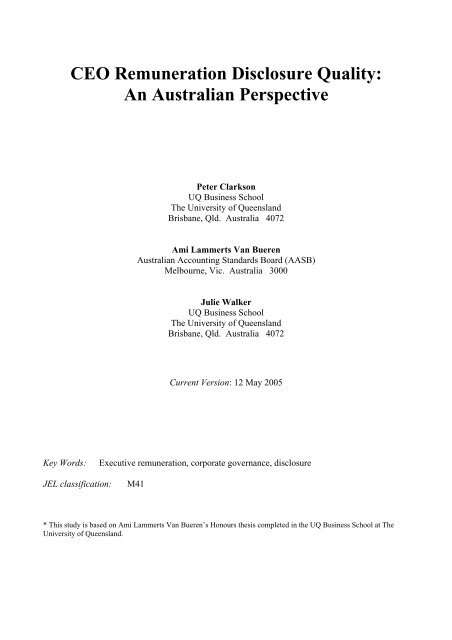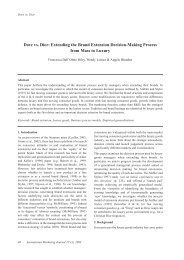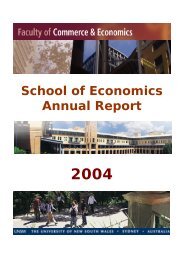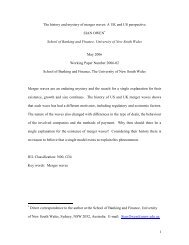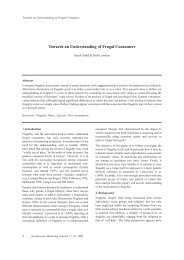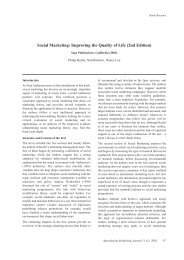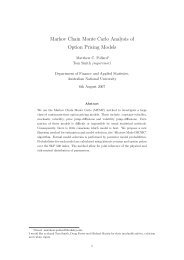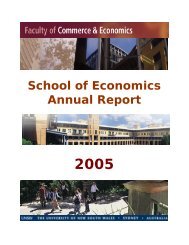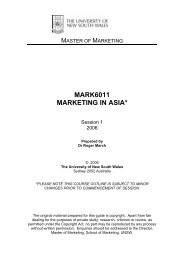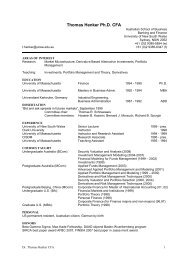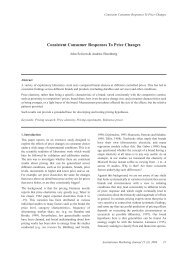CEO Remuneration Disclosure Quality: An Australian Perspective
CEO Remuneration Disclosure Quality: An Australian Perspective
CEO Remuneration Disclosure Quality: An Australian Perspective
You also want an ePaper? Increase the reach of your titles
YUMPU automatically turns print PDFs into web optimized ePapers that Google loves.
<strong>CEO</strong> <strong>Remuneration</strong> <strong>Disclosure</strong> <strong>Quality</strong>:<strong>An</strong> <strong>Australian</strong> <strong>Perspective</strong>Peter ClarksonUQ Business SchoolThe University of QueenslandBrisbane, Qld. Australia 4072Ami Lammerts Van Bueren<strong>Australian</strong> Accounting Standards Board (AASB)Melbourne, Vic. Australia 3000Julie WalkerUQ Business SchoolThe University of QueenslandBrisbane, Qld. Australia 4072Current Version: 12 May 2005Key Words:Executive remuneration, corporate governance, disclosureJEL classification:M41* This study is based on Ami Lammerts Van Bueren’s Honours thesis completed in the UQ Business School at TheUniversity of Queensland.
<strong>CEO</strong> <strong>Remuneration</strong> <strong>Disclosure</strong> <strong>Quality</strong>: <strong>An</strong> <strong>Australian</strong> <strong>Perspective</strong>AbstractThis study examines <strong>CEO</strong> remuneration disclosures for a sample of 100 <strong>Australian</strong> firms over theperiod 1998-2004. Our purpose is to determine whether the quality of disclosures improved overthat time period in response to (a) mandatory disclosure legislation and (b) the prominence ofexecutive remuneration in the financial press and general public arena as a consequence of severalhigh profile corporate collapses in 2001. The disclosure index that we employ is based upon thedisclosure requirements of AASB1046 and consists of the ten distinct items identified in thestandard. We find significant increases in the extent of <strong>CEO</strong> remuneration disclosure from 1998 to1999, concurrent with the introduction of CLRP98, and from 2003 to 2004, concurrent withAASB1046. In contrast, while we also find a systematic increase in the extent of disclosure in eachsuccessive year from 1999 through 2003, these increases are relatively more modest. In conjunctionwith this, we also find firm size, cross-listing, and corporate governance to be significantexplanators of <strong>CEO</strong> remuneration disclosure. In sum, we view this evidence as suggesting that, atleast in terms of <strong>CEO</strong> remuneration disclosure, the most effective means of enhancing disclosure isthrough formal regulatory channels. Based upon the reported results, moral suasion (e.g., externalstimuli such as the 2001 corporate collapses) and/or regulatory “fine tuning” appear less effectivedevices for effecting changes in disclosure.
1. Introduction1The level and nature of remuneration payments to executives in Australia has been a topicalissue for the financial press, investors and regulators over the past several years (Dunlop, 2000). InAustralia, detailed disclosures regarding executive remuneration have only been required forcompanies with fiscal years ending on or after 1 July 1998 following the introduction of theCompany Law Review Act 1998 (CLRA98). However, while CLRA98 formalised disclosurestandards, concerns continued regarding the extent of required remuneration disclosure relative tothe more detailed disclosure required in the U.S. and the U.K., and also in terms of theimplementation of CLRA98. In response to concerns regarding implementation, ASIC issuedPractice Note 68 (PN68) in November 1998. In response to the broader concerns regarding theextent of disclosure, the <strong>Australian</strong> Government proceeded with continuous modifications toexisting remuneration legislation, most recently Company Law Economic Reform Program 9(CLERP 9) which was passed in legislation in June 2004. Concurrent with the evolving regulatoryframework, expressing concern regarding the extent and quality of remuneration disclosure, the<strong>Australian</strong> Accounting Standards Board issued Exposure Draft 106 (“Director and Executive<strong>Disclosure</strong>s by Disclosing Entities”) in May 2002 and ultimately issued AASB1046 (“Director andExecutive <strong>Disclosure</strong>s by Disclosing Entities”) in January 2004. The evolution of the disclosurestandards over the period from the introduction of CLRA98 in July 1998 and the issuance ofAASB1046 and CLERP 9 in 2004 is described in Appendix A.In this study, we examine the extent of, and changes in, disclosure relating to ChiefExecutive Officer (<strong>CEO</strong>) remuneration found in the annual reports of a sample of 100 <strong>Australian</strong>companies over the seven-year period 1998 – 2004. We predict that there should be an increase inthe extent of disclosure in response to the introduction of CLRA98 which mandated enhanceddisclosure along specified lines and in response to the issuance of AASB1046 which explicitly laidout detailed disclosure requirements. In addition, we argue that the extent of disclosure may alsoincrease concurrent with changes in market attitudes regarding disclosure following from events
2such as the well documented corporate collapses in 2001 and various subsidiary interventions byregulatory bodies over the seven-year period between CLRA98 and AASB1046. The disclosureindex that we employ is based upon the disclosure requirements of AASB1046 and consists of theten distinct items identified in the standard. We use AASB1046 as the basis of index because itrepresents the culmination of the regulatory process regarding disclosure and because itencapsulates all of the disclosures envisaged throughout the evolution of the process.We focus narrowly on disclosure relating to the <strong>CEO</strong> for three basis reasons. First, s300A(c)of CLRA98 required disclosure of the nature and amount of each element of the emolument for eachdirector and for each of the five officers of the company receiving the highest emolument.AASB1046 refined this requirement to explicitly require disclosure relating to the <strong>CEO</strong>. Since the<strong>CEO</strong> will (almost) always be among the five highest remunerated officers, focusing on the <strong>CEO</strong>should ensure a consistent disclosure framework. Second, the role and responsibilities of the <strong>CEO</strong>within an organisation are generally well understood. Thus, on balance, stakeholders and otherinterested outside parties should typically be best positioned to evaluate pay-to-performance issuesas they relate to the <strong>CEO</strong> and as such, disclosure relating to <strong>CEO</strong> remuneration should consistentlybe of interest to outside parties. Third, in recent times, the <strong>CEO</strong> has been a primary target of thepress in articles focusing on excessive payouts. As such, <strong>CEO</strong> remuneration is of great interest to anumber of stakeholders (Hill & Yablon, 2002).Our results reveal significant increases in the extent of <strong>CEO</strong> remuneration disclosure from1998 to 1999, concurrent with the introduction of CLRP98, and from 2003 to 2004, concurrent withAASB1046. In contrast, while they also reveal a systematic increase in the extent of disclosure ineach successive year from 1999 through 2003, these increases are relatively more modest. In sum,we view this evidence as suggesting that, at least in terms of <strong>CEO</strong> remuneration disclosure, the mosteffective means of enhancing disclosure is through formal regulatory channels. Based upon thereported results, moral suasion (e.g., external stimuli such as the 2001 corporate collapses) and/orregulatory “fine tuning” appear less effective devices for effecting changes in disclosure.
3This paper contributes to the research literature in two ways. First, it provides much neededevidence on an important disclosure, <strong>CEO</strong> remuneration, that has only recently been mademandatory (CLRA98, July 1998) and for which formal and explicit disclosure requirements haveonly just been released (AASB1046, January 2004). By examining the quality of executiveremuneration disclosures over the period 1998-2004, we provide evidence on the disclosure qualityissue initially in the absence of a detailed accounting standard and latterly upon its release. Twofactors in particular are advanced and considered as possible drivers of improved disclosure: (1) theimpact of ongoing regulatory interest in the issue as evidenced by CLRA98, PN68, CLERP 9, andultimately AASB1046 and (2) enhanced public scrutiny and awareness as a consequence of thecorporate collapses of 2001, many of which focused on the issue of executive remuneration.Second, it also contributes to the disclosure literature in general. Substantial research hasbeen conducted on the relationship between the internal characteristics of a firm and disclosure.This paper aims to provide information on the relationship between an external factor anddisclosure by investigating whether market forces as a consequence of corporate collapses influenceremuneration disclosure. As corporate collapses are an inevitable event of the future, evidenceregarding their influence should aid in the development of future standards.Finally, neither CLERP 9 nor AASB1046 were in place during the early stages of our studyperiod. However, given the intense regulatory interest in executive remuneration disclosure duringthis earlier period, it is of interest to investigate whether firms responded by improving theirdisclosure quality, thereby possibly forestalling further binding regulation, or whether instead firmswaited until the regulations became mandatory in 2004 before making better quality disclosures.The remainder of the paper is organised as follows. In the next section, we review therelevant regulatory and institutional developments relating to <strong>CEO</strong> remuneration disclosure over thestudy period, concluding with a summary of the potential empirical implications. This is thenfollowed by a description of the empirical methodology in Section 3 and the sample data in Section4. Section 5 presents the empirical results and Section 6 presents a summary and conclusions.
2. Regulatory and public pressures on disclosure42.1 Regulatory and Institutional Events Affecting <strong>Remuneration</strong> <strong>Disclosure</strong>As noted above, detailed disclosures regarding executive remuneration were first required inAustralia with the introduction of CLRA98. Over the ensuing years, regulatory bodies undertook anumber of modifications and clarifications to the disclosure requirements including the issuance ofPN68 in November 1998, the release of MR03-202 by ASIC in June 2003, and the passing ofCLERP 9 in June 2004. From an accounting perspective, the primary events were the release ofExposure Draft 106 in May 2002 and the adoption of AASB1046 in January 2004. The evolution ofthe disclosure standards over the period from the introduction of CLRA98 in 1998 to the issuance ofAASB1046 and adoption of CLERP 9 in 2004 is described in Appendix A. Following is a moredetailed discussion of the various relevant events.As part of its Company Law Economic Reform Program (CLERP), the <strong>Australian</strong>Government introduced the Company Law Review Bill 1997, which later evolved to become theCompany Law Review Act 1998 (CLRA98). Its application was consistent with pressure fromvarious shareholder groups such as the (former) <strong>Australian</strong> Investment Managers Association(AIMA) (now the Investment and Financial Services Association (IFSA)) to increase the disclosureof directors’ and executives’ remuneration in line with the more detailed requirements of the U.S.and U.K.’s best practice disclosure methods. 1Specifically, s300A of CLRA98, which applied to listed companies with financial yearsending on or after 1 July 1998, required the following to be included in the directors’ report:(a) a discussion of the broad policy for determining the nature and amounts of emoluments ofboard members and senior executives of the company;(b) a discussion of the relationship between such policy and the company’s performance; and1 Unlike the U.S. or U.K., under Australia’s Corporations Law Schedule 5 as prescribed in AASB 1017 AASB 1034,prior to 1998 the only required disclosure was the number of executives within each $10,000 band above $100,000.Nevertheless, shareholders were still expected, according to <strong>Australian</strong> Stock Exchange (ASX) listing rules, to approvethe increases in the aggregate level of remuneration to non-executive directors and to vote on resolutions for thegranting of options. See Ernst & Young Corporate Governance Series April (1999) for further information on the Codeof Best Practice.
(c) details of the nature and amount of each element of the emolument of each director and eachof the 5 named officers of the company receiving the highest emolument.Further, s300(1)(d) which applied to all reporting entities under Chapter 2M of the Act requireddisclosure of details of options granted to directors and executive officers as a part of theirremuneration. Listed companies were also encouraged, although not required, to discloseinformation showing how option values have been determined, for example, the model used, inputsto the model, historical and expected volatility, the risk-free interest rate, assumptions on vestingand other significant assumptions affecting the value. <strong>Disclosure</strong> on the grant and vesting dates ofthe options and a description of the basis of recognizing the options over time was also encouraged.s300A was, however, a late amendment to the CLRA 98 and sparked heated debateregarding its inclusion. Issues raised included those by the ASX who claimed, “No disclosurecomes without cost” and doubted whether the detailed remuneration disclosure would add anyvalue. In their submission, Ernst and Young (EY) recommended the removal of s300A due to theambiguities and inconsistencies particularly in the use of its terms, for example, “officers” and“emoluments” and its replacement by an accounting standard on directors’ and executives’remuneration because “accounting matters ought to be left to the accounting standards”. 2In response to these (and other) concerns relating to s300A, ASIC issued PN68. Its purposewas to clarify some of the accounting-related requirements introduced by CLRA98. It indicated thatthe new Corporations Law provisions were to be interpreted in accordance with the overallobjectives of the legislation and that too much focus should not be given to words such as“emoluments” and “officers”. PN68 also stated that it was not ASIC’s intention to prescribedetailed accounting or valuation methods in relation to shares or options and further, that it believedthat the International Accounting Standards Boards’ Exposure Draft ED2 (‘Share-Based Payment’)provided a basis for valuing options and allocating those values over time and viewed it appropriateto draw on for the purposes of the disclosure of emoluments of directors and executive officers.52 Joint Committee on Corporations and Securities: CLRA Discussion, Statement by participants, 16 June 1999 –Parliament of Australia Website.
More recently, the Draft CLERP 9 Bill entitled “Audit Reform and Corporate <strong>Disclosure</strong>”,was released on 8 October 2003 by the <strong>Australian</strong> Government and then subsequently passed inJune 2004 as CLERP (Audit Reform and Corporate <strong>Disclosure</strong>) Act 2004. The Bill recognises theinadequacies in the current remuneration legislation, proposing the following changes in relation tothe transparency and accountability of directors and company management remuneration:• require disclosures to be in a clearly identified section of the annual directors’ report (i.e.<strong>Remuneration</strong> Report);• expand the range of disclosures required;• apply the disclosure requirements to senior managers employed within a corporate group;• allow shareholders the opportunity to discuss the remuneration section of the annualdirectors’ report and vote on a non-binding resolution; and• provide shareholders with greater say in relation to the termination benefits of directors.Failure to keep the market informed will result in on-the-spot fines for listed companies. 3Finally, AASB 1046 (‘Director and Executive <strong>Disclosure</strong>s by Disclosing Entities’) wasreleased in January 2004 and is operative for reporting dates on or after 30 June 2004. AASB 1046addresses many of the problems identified in s300A. In particular, it sets out detailed and explicitreporting or disclosure guidelines including rules for the valuation and disclosure of those values forequity based compensation, as well as clarifying many definitional issues. A list of the ten distinctitems requiring disclosure according to AASB1046 can be found in conjunction with the disclosurescoring index in Appendix B, along with a brief description of the associated disclosureexpectations and positioning of AASB1046 relative to s300A and PN68.62.2 Public Perceptions of Executive <strong>Remuneration</strong>Arguably, an additional driver of regulatory attention to executive remuneration disclosures inAustralia has been a series of corporate collapses that have created a great deal of adverse publicityrelating to the level and nature of payments made to senior executives of the failed firms (e.g., HIH,3 www.treasury.gov.au ‘CLERP Paper No. 9 (Audit Reform and Corporate <strong>Disclosure</strong>) Bill 2003’.
7One-Tel, Harris Scarfe, Impulse Airlines, <strong>An</strong>sett and Pasminco all of which were placed intoadministration in the 2001/2002 financial year). The levels of remuneration paid to seniorexecutives of these failed firms has been a particularly controversial issue that has focused publicattention on remuneration disclosures in general. 42.3 ResearchIimplicationsThe preceding discussion strongly suggests that the issue of executive remunerationdisclosure was prominent on both the regulatory agenda and in the financial press during the period1998-2004. 5 Given the apparent importance of this issue in the public arena, our study examines thedisclosure response of a sample of <strong>Australian</strong> firms to both regulatory and attitudinal changes(moral suasion) regarding disclosure by examining the extent of <strong>CEO</strong> remuneration disclosure overthe five year period 1998 – 2004. In particular, we argue that:(1) there should be an increase in the extent of <strong>CEO</strong> remuneration disclosure between 1998 and1999 in response to the introduction of CLRP 98 (followed by the release PN 68) whichmandated enhanced disclosure along specified lines;(2) there should be an increase in the extent of <strong>CEO</strong> remuneration disclosure between 2003 and2004 in response to the issuance of AASB1046 which laid out explicit and detailedremuneration disclosure requirements;(3) the extent of <strong>CEO</strong> remuneration disclosure potentially increased over the period 1999 to2003 concurrent with changes in market attitudes regarding disclosure following:(i)the introduction of and the continuing interest of regulators (and many other groups) inthe quality of executive remuneration disclosures;(ii) the corporate collapses that occurred during 2001 and resulted in significant adversemedia coverage on the issue of executive remuneration.; and(iii) the release by ASIC in June 2003 of guidelines for valuing options for directors andexecutives, and the concurrent announcement of enhanced enforcement relating tothese disclosures (MR03-202).4 Refer to the <strong>Australian</strong> Financial Review, (2002), “Why didn’t they see it coming”, for a discussion and summary of<strong>Australian</strong> firms that were placed into administration in 2001 and the reason given for their collapse.5 The controversy continues in 2003 with the Commonwealth Bank’s <strong>CEO</strong> Chris Cuff, BHP’s <strong>CEO</strong> Brian Gilbertsonand AMP’s <strong>CEO</strong> Paul Bachelor paid $33m, $38m and $1.4 million in severance pay respectively. Additionally, theCommonwealth Bank increased Chief Executive David Murray’s salary by $200,000 to $2.5 million at the same time asit cut 3,700 staff. (<strong>An</strong>derson, 2003; Jayne, 2003)
3. Methodology83.1 <strong>Disclosure</strong> IndexFor purposes of this study, we measure the extent of <strong>CEO</strong> remuneration disclosure using adisclosure index based upon the requirements of AASB1046. 6 A brief overview of ten distinct itemsidentified in AASB1046 as requiring disclosure is presented below. A detailed discussion of theitems is presented in Appendix B along with the particulars of the scoring index. We base ourdisclosure index on AASB1046 because, as discussed in the previous section, it represents theculmination of the regulatory process regarding remuneration disclosure which commenced withCLRP98 (notably s300A and s300(1)(d)) and PN68 in 1998 and because it effectivelyencapsulates/encompasses all of the disclosures envisaged throughout the evolution of theregulatory process.In brief, the ten disclosure requirements of AASB1046 are:1. Separate disclosure for the <strong>CEO</strong>2. Discussion of the remuneration process3. Discussion of the pay-to-performance relation or link4. Provision of comparative information5. Provision of disaggregated remuneration information according to specified categories6. Provision of disaggregated information regarding primary benefits7. Provision of disaggregated information regarding post-employment benefits8. Provision of disaggregated information regarding equity compensation9. Provision of detailed information regarding options granted including valuation details10. Provision of disaggregated information regarding primary benefits<strong>Disclosure</strong> is re-evaluated each year during the study period with equal weight beingassigned to each item. To ensure consistency, the disclosures were independently scored by twomembers of the research team. In the few instances where there was disagreement, the twomembers met to discuss and agree on the appropriate score. As can be seen from the <strong>Disclosure</strong>Index presented in Appendix B, the maximum possible <strong>CEO</strong> <strong>Remuneration</strong> <strong>Disclosure</strong> Score in any6 Given the inherent subjective bias in the use of a disclosure index, a word or page count method (Guthrie and Parker,1989) could be used as a secondary measure. We chose not to consider this alternative measure since there was noregulatory requirement that the relevant remuneration information appear in any specific section of the annual reportduring the majority of the study period. In fact, as discussed in Footnote 12, we find that the relevant remunerationinformation does, in fact, appear in many different parts of the annual report during all years of the study period.
9given year is 19 for companies which include options as a part of their compensation package butonly 16 for those that do not. We therefore scale the total disclosure score by the maximumavailable score in a given year and base our analysis on this scaled or relative measure ofremuneration disclosure quality (DISC).3.2 Empirical StrategyThe simplest approach for examining whether there has been a change (increase) in theextent of disclosure relating to <strong>CEO</strong> remuneration over the seven-year study period (1998 – 2004) isto compare the mean (and/or median) annual values of the scaled total disclosure measure. Thus, asa first step, we present results for a one-way ANOVA test of the equality of mean total disclosurescores across the seven years and related pair-wise comparison tests. In conjunction with this, wealso separately examine changes in the disclosure scores for each of the ten required disclosureitems which comprise the disclosure index.While a comparison of the mean scores can provide preliminary insights, the analysisignores other factors that potentially influence the disclosure decision and which may vary overtime. We therefore also consider two multiple regression models. First, in order to examine thestability of the disclosure measure over time, we adopt the following model:DISC t = β 0 + β 1 t + β 2 TA t + β 3 ROE t + β 4 GROW t + β 5 LEV t + β 6 CL t + β 7 <strong>CEO</strong> t+ β 8 TKOV t + β 9 GOV t + ε (1)where DISC t is the scaled total <strong>CEO</strong> remuneration disclosure score for year t (t = 1998, 1999, ….,2004) as described above and the remaining variables in the model are defined as follows:TA t = natural log of total assets for fiscal year t 7ROE t = net profit after tax divided by book value of equity as at the end of fiscal year tGROW t = book value of equity divided by market value of equity as at the end of fiscal year tLEV t = book value of debt / market value of equity as at the end of fiscal year t 87 Results using market capitalisation as an alternative measure of SIZE are qualitatively similar to those presented inTable 5.8 Results using total debt divided by total assets as an alternative measure of leverage (Klein 2002) are qualitativelysimilar to those presented in Table 5.
CL t = a categorical variable set equal to 1 if the firm is cross-listed internationally in yeart and 0 otherwise<strong>CEO</strong> t = a categorical variable set equal to 1 if the <strong>CEO</strong> is replaced during year t and 0otherwiseTKOV t = a categorical variable set equal to 1 if the company is subject to a takeover ormerger during year t and 0 otherwiseGOV t = the corporate governance factor for fiscal year t, constructed using factor analysisbased on four corporate governance measures, the proportion of independentdirectors on the board, the proportion of independent audit committee members,the proportion of independent remuneration committee members, and whether the<strong>CEO</strong> is also the chairman of the board.However, equation (1) can only be used to identify whether there has been a general trend inthe <strong>CEO</strong> remuneration disclosure scores but not to identify specific patterns that disclosure hasfollowed over the seven-year study period. As argued in Section 2, we believe that there potentiallycould (or should) be discrete changes in the disclosure score at a number of points throughout thestudy period such as, for example, between 1998 and 1999 (concurrent with the introduction ofCLRA98), between 2001 and 2002 (following the corporate collapses of 2001), and between 2003and 2004 (from 0.440 to 0.595), concurrent with the introduction of AASB1046. Thus, as a finalstep, we modify equation (1), replacing the time period variable, t, with year-by-year dummyvariables, D t (t = 1999, 2000, 2001, 2002, 2003, or 2004), to capture incremental disclosure in theyears 1999 through 2004 relative to 1998, respectively. The modified model we consider is then:DISC t = α +2004∑δt Dtt=1999+ γ 1 TA t + γ 2 ROE t + γ 3 GROW t + γ 4 LEV t + γ 5 CL t+ γ 6 <strong>CEO</strong> t + γ 7 TKOV t + γ 8 GOV t + ν (2)where D t is set equal to 1 in year t and 0 otherwise (t = 1999, …., 2004), and all remaining variablesare as previously defined. Within the context of this model, a pair-wise comparison of thecoefficients on the year-by-year dummy variables provides direct evidence on whether there havebeen changes in response to any, or all, of the events occurring between 1998 and 2004 related toremuneration disclosure10Since our analyses are based on the pooled sample of 700 firm-year observationscomprising 7 years of data on each of 100 companies, we run the disclosure models (equations (1)
11and (2)) using a pooled GLS technique. In a cross-sectional time-series sample such as ours, theOLS assumption that all observations are independent can lead to misspecification due to serialcorrelation of the error terms for observations from the same company. The pooled GLS techniqueallows for cross-sectional heteroscedasticity and serial correlation, and provides a betterspecification by using within-company correlation coefficients as estimates of the autoregressiveparameters for each cross-sectional unit. The technique uses estimated autoregressive parameters totransform the observations and obtain more efficient estimators.The choice of control variables included in the models follows predominately from thevoluntary disclosure literature. Consistent with Lang and Lundholm (1993) and Clarkson et. al.(1999), among others, we expect larger firms to make better disclosures in general. In addition,larger companies are also more likely to have material and/or complex <strong>CEO</strong> remunerationarrangements and therefore more likely to benefit from disclosure. Thus, we expect a positiverelation between our DISC and our proxy for firm size, total assets (TA).A company’s performance is also likely to influence its <strong>CEO</strong> remuneration disclosuredecision, although the relation may be somewhat more complex. Specifically, consistent with Langand Lundholm (1993) and Clarkson et. al. (1999), we also expect firms with better financialperformance to make better disclosures in general. However, since the level of <strong>CEO</strong> remunerationis likely to be positively related to firm performance, firms with better performance mayalternatively have disincentives to disclose. Thus, we view the relation between DISC and ourproxy for firm performance, ROE, to be ambiguous.Healy, Hutton and Palepu (1999) and Lang and Lundholm (1993) suggest that thecompany’s information environment will also influence the extent of voluntary disclosure. Wetherefore include a proxy for growth opportunities (GROW), measured as the ratio of the book valueof equity to the market value of equity. Since firms with higher measures of GROW have a greaterproportion of their value in growth opportunities or other intangible assets, we expect that thequality of <strong>CEO</strong> remuneration disclosure will be lower. We include leverage (LEV), measured as the
12ratio debt to equity, in the model because firms with higher leverage typically have higher agencycosts. It is therefore expected that the extent of <strong>CEO</strong> remuneration disclosure can be used to, in part,mitigate these costs. Thus, we would expect a positive relation between DISC and LEV.Additionally, while comprehensive disclosure of individual <strong>CEO</strong> remuneration packages hasonly been required for <strong>Australian</strong> companies since 1 July 1998, similar disclosures were requiredprior to this date in other jurisdictions, particularly the US and UK. We therefore include a dummyvariable to identify companies that are cross-listed on foreign exchanges (CL). Also, since acompany’s <strong>CEO</strong> remuneration disclosure practices may change with the introduction of a new <strong>CEO</strong>and/or when a company has been subject to a takeover or merger, we also include dummy variablesto capture these events (<strong>CEO</strong> and TKOV, respectively).Finally, extensive literature cites the association of numerous corporate governancemechanisms with disclosure (e.g., Yermack, 1996). Arguably, companies with better corporategovernance are more likely to provide better disclosure regarding <strong>CEO</strong> remuneration. We thereforeinitially consider four measures of corporate governance using data from the annual report: (1) theproportion of independent directors on the board; (2) the proportion of independent audit committeemembers; (3) the proportion of independent remuneration committee members; and (4) whether the<strong>CEO</strong> is also the chairman of the board. <strong>An</strong> individual is defined as being “independent if he/she isnot an employee of the firm. If the company does not have an audit and/or remuneration committee,the proportion of independent committee members is set equal to zero. 9 In order to facilitate theempirical analyses, we then use factor analysis to construct a composite corporate governancemeasure from these four proxies. Our empirical results are based upon this composite corporategovernance measure. 109 This is consistent with the arguments presented by Clarkson, Ferguson, and Hall (2003) that the lack of a committee isfunctionally equivalent to a setting where the committee is composed exclusively of management.10 For our sample companies (discussed in the next section), the mean proportion of independent board members was69.83 percent, the mean proportion of independent audit committee members was 42.04 percent, and the meanproportion of independent remuneration committee members was 34.28 percent. Further, 88.40 percent of the boards,34.40 percent of the audit committees, and 25.60 percent of the remuneration committees have a majority ofindependent members. The proportion of companies with the <strong>CEO</strong> also serving as the chairman of the board is 14.80percent. The extent of overlap among the four proxies is, however, modest with the largest pairwise correlation being
4. Sample Data13The sample data consist of 100 companies randomly selected from the Connect 4 databasefor which annual reports could be obtained for all years during the seven-year study period, 1998 to2004, and which are not in the financial or extractive (metals and mining or oil and gas) industrysectors. 11 The availability of the annual reports for the complete period is necessary in order toensure a consistent sample on which to base an examination of changes in <strong>CEO</strong> remunerationdisclosure. Firms in financial sector are excluded because they face different regulatorycircumstances while firms in the extractive industries are excluded because of the significantdifferences in the nature of their business relative to industrials.We restrict our sample to 100 companies over the seven-year study period because, given alack of regulation specifying where <strong>CEO</strong> remuneration details are to be disclosed within the annualreport, remuneration disclosure can only be assessed by reading the annual reports in theirentirety. 12 We focus exclusively on the annual report appealing to Lang and Lundholm (1993) andClarkson et. al. (1999), among others, who document a significant relation between annual reportdisclosure and disclosure through other medium.Descriptive statistics for the pooled sample of 700 firm-years are presented in Table 1. Asrevealed in Panel A, there is considerable diversity in the characteristics of the sample. Forexample, the total assets of our sample companies (TA) ranges from $4.180 million to $84,961million, with a mean (median) value of $1,953.709 million ($500.522 million). The companies’ROE ranges from -276.3 percent to 210.8 percent with a mean (median) of 2.6 percent (9.5 percent).Firms also vary in terms of growth prospects (GROW), with some having relatively high nettangible assets per share, indicating fewer growth opportunities, while a number have negative nettangible assets per share, reflecting considerable potential for future growth. On average, firms are0.564 between the proportion of independent board members and the proportion of independent audit committeemembers.11 ASX Global Industry Classification Standards (GICS) 40, 151040 and 10102012 Such lack of concentration in remuneration disclosures is evidenced in this study, with information appearing inannual reports under headings such as corporate governance, director’s report, financial statements and notes to the
14somewhat levered (LEV); the mean (median) debt-to-equity ratio is 1.318 (0.585). Finally, thecorporate governance measure ranges from -0.526 to 2.291. 13Panel B reveals that 14.7 percent of our sample companies are cross-listed on foreignexchanges. It also reveals that a <strong>CEO</strong> is replaced in 13.3 percent of the company years andtakeovers occur during 1.0 percent of the company years. Finally, Panel C reveals that 16 industrysectors are represented in the sample.Table 2 presents a pair-wise correlation matrix for the various measures considered in theempirical models (equations (1) and (2)). As can be seen, the correlations suggest that the extent of<strong>CEO</strong> remuneration disclosure (DISC) is positively related to firm size (TA), company performance(ROE), leverage (LEV), cross-listing (CL), a change in <strong>CEO</strong> (<strong>CEO</strong>), the takeover variable (TKOV),and the corporate governance measure (GOV), and negatively related to growth (GROW). Clearly,however, these results are preliminary given their univariate nature. For the independent variables,the only correlation exceeding 0.5 is that between ROE and LEV (-0.510). Thus, the figures suggestthat the threat of multicollinearity is limited (Gujarati, 1995). 145. Empirical Results5.1 Univariate <strong>An</strong>alysis5.1.1. Overall <strong>CEO</strong> <strong>Remuneration</strong> <strong>Disclosure</strong> <strong>Quality</strong>Table 3 presents descriptive statistics for the total relative <strong>CEO</strong> remuneration disclosuremeasure (DISC) on a year-by-year basis over the seven-year study period, 1998 – 2004. Aspreviously discussed, DISC is constructed (by company and year) as the sum of the disclosurescores across the 10 items identified in AASB1046 scaled by the maximum score the company canaccounts. Such a limitation may not be present for future studies on remuneration as CLERP 9 proposes that futureremuneration disclosures be clearly identified in a section of the annual director’s report (i.e. ‘<strong>Remuneration</strong> Report’).13 As discussed in the previous section, in order to facilitate the empirical analyses, we use factor analysis to construct acomposite corporate governance measure from our four corporate governance proxies. The factor analysis indicates thatthere is only one identifiable factor underlying the four proxies. The eigenvalues for the first two factors are 2.047 and0.855. The communalities all exceed 0.400.14 For example, Gujarati (1995) argues that “multicollinearity will not be a problem, even with high pairwisecorrelations (in excess of 0.85), if there is sufficient variability in the values taken by the regressors.” As further support
15attain for a given year, with the maximum attainable score dependent upon whether the companyutilises options as a part of the compensation package.As can be seen from Panel A, the mean value of this measure is monotonic increasing overthe study period, starting with a value of 0.109 in 1998 and reaching a value of 0.595 in 2004. Thelargest increases occurred between 1998 and 1999 (from 0.109 to 0.289), concurrent with theintroduction of CLRA98, and between 2003 and 2004 (from 0.440 to 0.595), concurrent with theintroduction of AASB1046. Other increases are relatively more modest in magnitude. Thus, on thesurface, the pattern is consistent with conjectures regarding the effect of CLRA98 and AASB1046 onthe extent of <strong>CEO</strong> remuneration disclosure.Panel A also presents the F-statistic for the test of equality of mean disclosure measuresacross the seven-year study period. The reported F-value of 127.294 (p < 0.001) indicates that thenull hypothesis of equal mean total disclosure measures can be rejected, a conclusion supported bythe Kruskal-Wallis non-parametric test for equality of median values (χ 2 = 343.070, p < 0.001). Togain further insights into these test results, Tukey’s HSD pair-wise comparisons are presented inPanel B along with the identified Homogeneous Subsets in Panel C. The reported figures in Panel Bare the p-values for the test of whether the means are different. For example, comparing the meandisclosure measures for 1998 and 1999, p < 0.001. In contrast, comparing 1999 and 2000, p =0.512. Panel C summarises these results by grouping them into subsets for which the meanmeasures are not statistically different at the 0.05 level. Continuing, a detailed examination of the p-values reported in Panel B (and summarised in Panel C) reveals that the mean disclosure measuresfor 1998, 2003, and 2004 are each significantly different from all other mean disclosure measures atless than the 0.001 level of significance. In addition, they also reveal that there is a pattern of smallbut distinct increases over the period from 1999 through 2002, with the mean measure for 2001being significantly greater than its counterparts for both 1998 and 1999, and the mean measure for2002 being significantly greater than its counterparts for 1998, 1999, and 2000.for the view that multicollinearity is not a threat in any of our regressions, we consider the Variance Inflation Factor
16Thus, the results identify significant increases in disclosure quality concurrent with distinctregulatory change (e.g., CLRA98 in 1998 and AASB1046 in 2004) and provide support for theconjecture that regulatory change has led to enhanced <strong>CEO</strong> remuneration disclosure. However, theresults indicate that disclosure quality has also improved during periods when there has beenrelatively little regulatory activity, thereby suggesting that the driving forces behind increases indisclosure quality may not be restricted to regulatory changes.5.1.2. Component <strong>Disclosure</strong> ScoresTable 4 presents the maximum score available and the mean disclosure scores by year foreach of the ten elements underlying the <strong>CEO</strong> remuneration disclosure index. As can be seen, withonly one minor exception, the mean disclosure scores for each of the ten items have consistentlyincreased over the seven-year study period. Based on the reported F-statistics, equality of meandisclosure scores across the seven years is rejected at less than the 0.001 level of significance foreach item. Tukey HSD pair-wise comparisons (as summarised by the Homogeneous Subsetsreported in the final column of the Table) again reveal that both 1998 and 2004, years in whichthere have been significant regulatory changes play a primary role in the rejections of the nullhypotheses of equal mean scores.However, a more in depth examination of the scores reveals that the extent of disclosure,and change in extent of disclosure, across the ten items has not been uniform. For example, as earlyas 1999, virtually all companies provided separate disclosure for their <strong>CEO</strong> whereas in contrast,even by 2004, even though explicitly required by AASB1046, less than 50 percent of companiesprovided comparative information. In addition, as revealed in the Homogenous Subsets summary,for all but one item (6. Primary benefit), the disclosure scores for 2004 are significantly differentfrom those for all other years. Thus, one of the primary driving forces behind the improvements in<strong>CEO</strong> remuneration disclosure is clearly AASB1046.(VIF). The VIF’s (not reported) also support the view that we should not be concerned about multicollinearity.
175.1.3. SummaryIn summary, the results for the univariate analyses indicate that there has been a significantincrease in the extent of <strong>CEO</strong> remuneration disclosure over the seven-year study period, 1998 –2004, both overall and at the component level. However, the results also indicate that the largestincreases occurred between 1998 and 1999, concurrent with the introduction of CLRA98, andbetween 2003 and 2004, concurrent with AASB1046. Finally, an examination of the componentscores suggests that the most notable improvement in elements for which regulators haveconsistently requested discussion and insight, occurred in 2004.5.2 Regression ResultsTable 5 presents results for the <strong>CEO</strong> remuneration disclosure score models (equations (1)and (2)). As previously noted, the analyses are based on the pooled sample of 700 company-yearsand the regressions are run using GLS. The results for the basic model (equation (1)), reported inPanel A, reveal that the coefficient on the time variable, t, is positive and significant. Its coefficientis 0.064 (p < 0.001). Thus, as conjectured, the extent of <strong>CEO</strong> remuneration disclosure appears tohave increased over the five year study period. Consistent with predictions, we also find the positiveand significant coefficients on TA (0.032, p < 0.001), CL (0.059, p = 0.001), and GOV (0.031, p =0.005). The coefficients on all remaining variables are insignificant. 15 The adjusted R 2 for themodel is 0.506.Panel B presents results for the refined model (equation (2)) with the total disclosure scoreas its dependent variable. As can be seen, the coefficients on all year-by-year dummy variables(D 1999 , D 2000 , D 2001 , D 2002 , D 2003 , and D 2002 ) are positive and significant (p < 0.001 in eachcase).Thus, the extent of disclosure in each of the years 1999 through 2004 is significantly higherthan in 1998. In addition, the coefficients on TA (0.024, p < 0.001), CL (0.060, p < 0.001) and GOV15 GROW is weakly significant at the 10 percent level, one-tailed test (-0.011, p = 0.054)
18(0.030, p = 0.004) are also significant. All remaining coefficients are insignificant. The adjusted R 2for the model is 0.547.Panel B also presents p-values for the F-tests for the pair-wise comparisons of the year-byyeardummy variables coefficients. For example, the p-value for the linear restriction comparingdisclosure in 1999 with disclosure in 2000 (i.e., a test of the linear restriction δ 1999 = δ 2000 , thecoefficients on D 1999 and D 2000 , respectively) is 0.115. Thus, within the context of this model, weare unable to reject the null hypothesis of a difference between the extent of disclosure in 1999 and2000. More generally, consistent with the results from the univariate, the reported p-values indicatethat the mean disclosure measures for 1998, 2003, and 2004 are each significantly different from allother mean disclosure measures at less than the 0.001 level of significance. In addition, they alsoreveal that there is a pattern of small but distinct increases over the period from 1999 through 2002,with the mean measure for 2001 being significantly greater than its counterparts for both 1998 and1999, and the mean measure for 2002 being significantly greater than its counterparts for 1998,1999, 2001, and 2000.Finally, to gain further insights into the disclosure behaviour, we reran equation (2) usingalternatively each of the ten component disclosure items as the dependent variable. The results,presented in Panel C, reveal a consistent improvement in disclosure quality relating to each of theitems over the study period and thereby reinforce conclusions drawn from the univariate analysis. Inaddition, linear restriction tests (not reported) confirm the conclusions drawn from the univariatepair-wise comparison tests that the primary improvements occur from 1998 to 1999 and from 2003to 2004, concurrent with the adoptions of CLRA98 and AASB1046, respectively.In summary, the results from the various multiple regression models reveal several facts.First, they consistently indicate that the extent of <strong>CEO</strong> remuneration disclosure has increased overthe seven-year study period, 1998 – 2004. Further, the results of the linear restriction tests indicatethat the greatest improvements have occurred concurrent with the major regulatory events duringthe study period, the adoptions of CLRA98 and AASB1046 in 1998 and 2004, respectively. Second,
19they indicate that firm size, cross-listing status, and corporate governance mechanisms areimportant and consistent explanators of <strong>CEO</strong> remuneration disclosure, but other firm-specificfactors such as firm performance and leverage are not.6. Summary and ConclusionsIn this study, we examine changes in the extent of <strong>CEO</strong> remuneration disclosure over theperiod 1998 – 2004. We predict that there should be an increase in the extent of disclosure both inresponse to the introduction of CLRA98 in July 1998 which mandated enhanced disclosure alongspecified lines and to the issuance of AASB1046 in January 2004 which explicitly laid out detaileddisclosure requirements. In addition, we also argue that the extent of disclosure may also increaseconcurrent with changes in market attitudes regarding disclosure following from events such as thenewsworthy corporate collapses in 1991 and/or with regulatory “fine tuning” throughout theintervening years between CLRA98 and AASB1046. The disclosure index that we employ is basedupon the disclosure requirements of AASB1046 and incorporates the ten distinct items identified inthe standard. The sample we consider consists of 100 companies randomly selected from theConnect 4 database for which data could be obtained for all years in the study period.Consistent with predictions, we find significant increases in the extent of <strong>CEO</strong> remunerationdisclosure from 1998 to 1999, concurrent with the introduction of CLRA98, and from 2003 to 2004,concurrent with the issuance of AASB1046. In contrast, while we also find a systematic increase inthe extent of disclosure in each successive year from 1999 through 2003, these increases arerelatively more modest. In conjunction with this, we also find that firm size, cross-listing, andcorporate governance to be significant explanators of <strong>CEO</strong> remuneration disclosure.In sum, we view this evidence as suggesting that, at least in terms of <strong>CEO</strong> remuneration disclosure,the most effective means of enhancing disclosure is through formal regulatory channels. Basedupon the reported results, moral suasion (e.g., external stimuli such as the 2001 corporate collapses)and/or regulatory “fine tuning” appear less effective devices for effecting changes in disclosure.
Bibliography:20<strong>An</strong>derson, F., (2003), “Laws Force Bosses to Cut Golden Parachutes”, Courier Mail, October 9.<strong>Australian</strong> Accounting Standards Board, (February 1997), AASB1017: Related Party <strong>Disclosure</strong>s.<strong>Australian</strong> Accounting Standards Board, (October 1999), AASB1034: Financial ReportPresentation and <strong>Disclosure</strong>s.<strong>Australian</strong> Accounting Standards Board, (January 2004), AASB 1046: Director and Executive<strong>Disclosure</strong>s by Disclosing Entities.<strong>Australian</strong> Financial Review, (2002), “Why Didn’t They See it Coming”.<strong>Australian</strong> Securities and Investment Commission, (1998), Practice Note 68, New FinancialReporting and Procedural Requirements.<strong>Australian</strong> Society of CPAs, (1998), “Understanding the Company Law Review Act 1998”.<strong>Australian</strong> Stock Exchange, (2001), “Option Pricing Models”,http://www.asx.com.au/markets/l4/PricingModels_AM4.shtmClarkson, P.M., C. Ferguson, and J. Hall (2003), “Auditor conservatism and voluntary disclosure:Evidence from the Year 2000 systems issue”, Accounting and Finance, 43(1), 21 – 40.Clarkson, P.M., J.L. Kao, and G.D. Richardson (1999), “Evidence that Management Discussion and<strong>An</strong>alysis (MD&A) is a part of a firm’s overall disclosure package, ContemporaryAccounting Research, 16(1), 111-134.Coulton, J., C.James and S.Taylor, (2002), “The Effect of Compensation Design and CorporateGovernance on the Transparency of <strong>CEO</strong> Compensation <strong>Disclosure</strong>s”, Working Paper,University of Technology, Sydney.Dunlop, I., (2000), “Get Tough on Salary Excesses”, <strong>Australian</strong> Financial Review, November 21,p51.Ernst and Young (1999), “Best practices in the disclosure of directors’ and executives’remuneration”, Ernst and Young Corporate Governance Series, Ernst and Young Australia,April 1999.Gujarati, D.M. (1995), Basic Econometrics, 3 rd edition, New York: McGraw-Hill InternationalEditions.Guthrie, J. and L. Parker., (1983), “Corporate Social Reporting: A Rebuttal of Legitimacy Theory”,Journal of Accounting and Business Research, 19, pp. 343-354.Healy, P., A. Hutton., and K. Palepu., (1999), “Stock Performance and Intermediation ChangesSurrounding Sustained Increases in <strong>Disclosure</strong>”, Contemporary Accounting Research, 16,pp. 485-520.Hill, J. and C. Yablon., (2002), “Corporate Governance and Executive <strong>Remuneration</strong>:Rediscovering Managerial Positional Conflict”, UNSW Law Journal, 25, pp. 294-319
21Jayne, V., (2003), “Just What Are <strong>CEO</strong>s Worth?”, The Director, June 2003Johnston, L., and D. Kitney., (2002), “Executives Salaries Under Pressure”, <strong>Australian</strong> FinancialReview, November 6Lang, M., and R. Lundholm., (1993), “Cross-Sectional Determinants of <strong>An</strong>alyst Ratings ofCorporate <strong>Disclosure</strong>s”, Journal of Accounting Research, 31, pp. 246-271 77Yermack, D., 1996. Higher market valuation of a company with a smaller board of directors.Journal of Financial Economics, 40, 185-211.
Appendix A: Regulatory and Institutional Events Affecting <strong>CEO</strong> <strong>Remuneration</strong><strong>Disclosure</strong>22July 1998November 1998May 2002May 2003June 2003October 2003January 2004June 2004September 2004Company Law Review Act (CLRA) 1998 became law in July 1998. s300and s300A presents disclosure requirements relating to director andexecutive remuneration. CLRA98 applied to annual reports for companieswith financial years ending on or after 1 July 1998.ASIC issued Practice Note 68 to clarify issues relating to s300A and s300(1)(d).Exposure Draft 106 Part 1 Director and Executive <strong>Disclosure</strong>s byDisclosing Entities issued by the <strong>Australian</strong> Accounting Standards Board.ASIC releases MR03-147 Draft Guidelines on the Value of Options inDirectors. Reports”ASIC releases MR03-202 Valuing Options for Directors and Executives.ASIC states that it will enforce disclosure of options values.Draft CLERP 9 Bill, “Audit Reform and Corporate <strong>Disclosure</strong>” released.AASB 1046, Director and Executive <strong>Disclosure</strong>s by Disclosing Entitiesissued. Operative for reporting periods on or after 30 June 2004.Draft CLERP 9 Bill passed as CLERP (Audit Reform and Corporate<strong>Disclosure</strong>) Act 2004. The Act comes into force on 1 July 2004.AASB 1046A Amendment to Accounting Standard AASB 1046 released.This amendment makes the measurement rules in relation to equity-settledshare-based payments consistent with those contained in AASB 2 ShareBased Payment. The AASB could have delayed the release of AASB 1046so that it occurred after AASB 2 was finalised and would hence have beenconsistent with that standard, however, as the preface to AASB1046Astates:In January 2004, the AASB issued AASB 1046 Director and Executive<strong>Disclosure</strong>s by Disclosing Entities, effective for periods ending on andafter 30 June 2004. Since its initiation in 1998, the project has beensubject to many changes and delays, waiting for other developments tocrystallise. It could have been delayed even further, waiting on the finalversions of the CLERP 9 proposals and the expected Standard on sharebasedpayment from the IASB. However, the AASB decided furtherdelay in improving the current corporate disclosure regime inAustralia could not be justified. Although resolution of the other issuesmight improve the Standard, the time frame was uncertain and the benefitsprobably marginal. The Board decided to issue AASB 1046, referring toother AASB Standards current as at January 2004 and to schedule arevision shortly before those references become meaningless when theStandards are replaced by the <strong>Australian</strong> equivalents to IASB standards.(Emphasis added).
Appendix B: Components of the <strong>CEO</strong> <strong>Remuneration</strong> <strong>Disclosure</strong> Index (D REM )23Element Coding Index Section 300; Practice Note 68 AASB 10461. Separate disclosure for<strong>CEO</strong>0 = No1 = Yesrequired: s300A(1)(c); PN68.55each of the 5 named officers of thecompany receiving the highestemolumentrequired: para 7.1, 4.1(b)each specified executive with specifiedexecutive being the five or moreexecutives with the greatest authority forstrategic direction and management of theentity2. <strong>Remuneration</strong> Process0 = No discussion1 = General discussion of process2 = Detailed discussion of process (i.e.,disclosing how the body responsible forsetting remuneration determined <strong>CEO</strong>compensation ex ante such as, for example,benchmarking procedures against competingfirms or a relevant index)required, no details specified:300A(1)(a); PN68.51discussion of broad policy fordetermining the nature and amount ofemolumentsrequired, details given: para 7.57.5(a) the principles used to determine thenature and amount of remuneration7.5(c) for each contract for services, suchexplanations as are necessary …. toprovide an understanding of how theamount of remuneration in the currentreporting period was determined and howthe terms of the contract affectremuneration in future periods(elaborated upon in 7.5.1)3 = Detailed discussion of process,including bonus plan (i.e., category 2 plusdetails of bonus plans such as terms andconditions)7.5(d) details of bonus plans – requiresterms and conditions of each grant ofperformance-based benefits be disclosed(elaborated upon in 7.5.2, 7.5.3)3. Pay-to-performancerelation / link0 = No discussionrequired, no details specified:300A(1)(b); PN68.51required, no details specified: para7.5 (b)1 = Broad discussion of pay to performancelink (e.g. incentives with business results)2 = Detailed discussion of pay to performancelink (e.g., long term/short term remuneration,goals, percentages, actual type of payout suchas shares or cash, etc.)discussion of the relationship betweensuch policy and the company’sperformancewhether, and if so how, the principles(used to determine the nature and amountof remuneration) establish a relationshipbetween remuneration and the entity’sperformance
244. ComparativeInformation0 = No1 = Yesnot requiredno mention in s300 or s300APN68 explicitly states is not requiredrequired: para 11.1 (a), (b)financial information for the precedingreporting period that corresponds to thedisclosures required by this Standard forthe reporting period must be disclosed5. Disaggregatedremuneration0 = Aggregated information only1 = Partial or alternative disaggregation2 = Disaggregation as per AASB1046required, partial details:300A(1)(c) & (d); PN68.60details of the nature and amount of eachelement of emolument (various itemsidentified but no format provided)items explicitly identified in s300 are:dividends or distributions; options;indemnities given; insurance premiumspaid; fringe benefits; superannuationcontributions; retirement benefitsrequired, details: para 5.2four categories (primary benefits; postemploymentbenefits; equitycompensation; other compensation), withfurther disaggregation within eachcategory(note: the components identified inSection 300 and PN68.61 are a propersubset of the items identified inAASB1046)PN68.60 – elements would normallyinclude salary and fees, non-cash benefits,bonuses (possibly separate categorieswhere bonuses are based on differentperformance criteria), profit share,superannuation contributions, otherpayments in connection with retirement,the value of shares issued, and the valueof options grantedPN68.61 – foregoing is intended to assistdirections – there may be elements whichare significant – it remains theresponsibility of directors to determinewhich elements are relevant in thecircumstances of the company and whichneed to be disclosed …. within the spiritof the new s300A6. Primary benefit0 = Aggregatedrequired: s300A(1)required: para1 = Disaggregated as per AASB1046various items identified but nospecified formal providedthree components: (1) cash salary,fees, and commissions; (2) cashprofit-sharing and other bonuses; and(3) non-monetary benefits
257. Post-employmentbenefits0 = Aggregated1 = Disaggregated as per AASB10462 = Disaggregated as per AASB1046 anddetailed discussion of retirement plansand/or allowances (e.g. list of actualconditions/obligations, dollar values etc.)required, partial details: s300A(1)various items identified but nospecified formal providedrequired: parathree components: (1) pension andsuperannuation benefits; (2)prescribed benefits; and (3) otherpost-employment benefits8. Equity compensation0 = Aggregatedrequired, partial details: s300A(1)required: para1 = Partial disaggregation2 = Disaggregated as per AASB1046various items identified but nospecified formal providedfour components: (1) value of sharesand units; (2) value of options andrights; (3) impact of changes in terms;and (4) value of other equitycompensation9. Option valuation details0 = No details providedrequired: s300 (1), (5)required: para 8.21 = Broad or partial discussion of optionsgranted (e.g., exercise price, expiry date& exercise date) but no valuation detailsprovided2 = Valuation method and option valuedisclosed3 = Valuation method and option valuedisclosed, along with valution modelinputs (i.e., exercise price, expiry date,exercise date, risk-free rate, volatility)s300(1)(d) – details of optionss300(5), (6) – details include number andclass of shares over which options aregranted, issue price, expiry date,8.2(a) – number of options and rightsgranted and vested8.2(b) particulars of terms and conditionsof each grant including value, exerciseprice, amount paid/payable by recipient,expiry date, date when may be exercised,and summary of service and performancecriteria that must be met beneficialinterest vests10. Other compensationbenefits0 = Aggregated1 = Disaggregated as per AASB10462 = Disaggregated and other benefitsidentified and discussedRequired, no details provided:s300A(1)various items identified but nospecified formal providedrequired: parathree components: (1) terminationbenefits; (2) prescribed benefits; and(3) all other benefits
26Table 1Descriptive Statistics for a Sample of 100 <strong>Australian</strong> Companies from the period 1998 – 2004Panel A: Continuous MeasuresVariable Mean Median Std Dev Minimum MaximumTA 1,943.709 500.522 6,430.318 4.180 84,961.000ROE 0.026 0.095 0.450 -2.763 2.108GROW 0.786 0.596 1.051 0.021 15.993LEV 1.318 0.585 3.349 0.002 50.450GOV 1.706 1.901 0.550 -0.526 2.291Panel B: Dichotomous VariablesVariableProportionCL 0.147<strong>CEO</strong> 0.133TKOV 0.010Panel C: Industry RepresentationIndustry# CompaniesCapital Goods 11Chemicals 2Commercial Serv. & Supply 8Construction Materials 4Containers & Packaging 2Food, Beverage & Tobacco 17Health Care Equipment & Serv. 9Hotels, Restaurants and Leisure 4Media 11Pharmaceuticals & Biotech 8Retailing 8Real Estate 5Software & Services 2Telecommunications Supply 3Transportation 5Utilities 1Variable definitions: TA is the book value of assets in $ millions; ROE is the firm’s net profit after tax dividedby book value of equity; GROW is the ratio of the firm’s book value of equity to its market value of equity; LEV is theratio of the firm’s total debt to equity; GOV is the corporate governance factor for fiscal year t, constructed using factoranalysis based on four corporate governance measures, the proportion of independent directors on the board, theproportion of independent audit committee members, the proportion of independent remuneration committee members,and whether the <strong>CEO</strong> is also the chairman of the board; CL is a categorical variable set equal to 1 if the firm is crosslistedinternationally and 0 otherwise; <strong>CEO</strong> is a categorical variable set equal to 1 if the <strong>CEO</strong> is replaced during year tand 0 otherwise; and TKOV is a categorical variable set equal to 1 if the company is subject to a takeover or mergerduring year t and 0 otherwise.
Table 2Pearson Correlation Matrix for a Sample of 100 <strong>Australian</strong> Companies (700 company-years) from the Period 1998 – 200427DISC 1.000t 0.695 ** 1.000TA 0.340 ** 0.086 1.000ROE 0.114 ** 0.032 0.157 ** 1.000GROW -0.122 ** 0.186 ** 0.062 0.024 1.000LEV 0.116 ** 0.034 0.115 * -0.261 ** 0.510 ** 1.000CL 0.101 ** 0.077 0.322 ** -0.069 -0.082 * 0.039 1.000<strong>CEO</strong> 0.102 * 0.158 * -0.031 0.033 -0.029 0.018 0.008 1.000TKOV 0.101 * 0.088 * 0.043 0.020 -0.045 -0.030 -0.042 0.060 1.000GOV 0.234 ** 0.136 ** 0.240 ** 0.150 ** 0.148 * 0.029 0.137 * 0.076 0.049 1.000DISC t TA ROE GROW LEV CL <strong>CEO</strong> TKOV GOVVariable definition: DISC, the measure the extent of <strong>CEO</strong> remuneration disclosure, is based on the ten distinct items identified in AASB1046 as requiring disclosure (theseitems and the disclosure scoring index are described in Appendix B); TA is the book value of assets in $ millions; ROE is the firm’s net profit after tax divided by book value ofequity; GROW is the ratio of the firm’s book value of equity to its market value of equity; LEV is the ratio of the firm’s total debt to equity; GOV is the corporate governance factorfor fiscal year t, constructed using factor analysis based on four corporate governance measures, the proportion of independent directors on the board, the proportion of independentaudit committee members, the proportion of independent remuneration committee members, and whether the <strong>CEO</strong> is also the chairman of the board; CL is a a categorical variable setequal to 1 if the firm is cross-listed internationally and 0 otherwise; <strong>CEO</strong> is a categorical variable set equal to 1 if the <strong>CEO</strong> is replaced during year t and 0 otherwise; and TKOV is acategorical variable set equal to 1 if the company is subject to a takeover or merger during year t and 0 otherwise.*Significant at the 5 percent level, two-tailed test.** Significant at the 1 percent level, two-tailed test.
28Table 3Descriptive Statistics for Scaled <strong>CEO</strong> <strong>Remuneration</strong> <strong>Disclosure</strong> Scores (DISC) for a Sample of100 <strong>Australian</strong> Companies over the period 1998 - 2004Panel A: Overall <strong>CEO</strong> <strong>Remuneration</strong> Score (DISC)Year Mean Median Std. Dev. Min Max1998 0.109 0.063 0.097 0.000 0.4701999 0.289 0.313 0.117 0.000 0.5302000 0.323 0.316 0.123 0.000 0.5802001 0.345 0.316 0.125 0.000 0.6302002 0.379 0.364 0.129 0.000 0.8402003 0.440 0.438 0.149 0.060 0.8102004 0.595 0.579 0.153 0.060 1.000Test statistic a 127.294(< 0.001)343.070(< 0.001)Panel B:Tukey HSD Pairwise Comparison p-values1998 1.0001999 < 0.001 1.0002000 < 0.001 0.512 1.0002001 < 0.001 0.049 0.925 1.0002002 < 0.001 < 0.001 0.039 0.461 1.0002003 < 0.001 < 0.001 < 0.001 < 0.001 0.018 1.0002004 < 0.001 < 0.001 < 0.001 < 0.001 < 0.001 < 0.001 1.0001998 1999 2000 2001 2002 2003 2004Panel C: Mean Scores for Homogenous Subsets (α = 0.05)Year Subset #1 Subset #2 Subset #3 Subset #4 Subset #5 Subset #61998 0.1091999 0.2892000 0.323 0.3232001 0.345 0.3452002 0.3792003 0.4402004 0.595a DISC, the measure the extent of <strong>CEO</strong> remuneration disclosure, is based on the ten distinct items identified inAASB1046 as requiring disclosure (these items and the disclosure scoring index are described in Appendix B).b F-test for the test of equality of mean disclosure scores or Chi-square test for equality of median disclosurescores across the five years, as appropriate (p-values in parentheses).
Table 4Mean <strong>CEO</strong> <strong>Remuneration</strong> Component <strong>Disclosure</strong> Scores for a Sample of 100 <strong>Australian</strong> Companies over the period 1998 – 2004 a29<strong>Disclosure</strong> ItemMaxScore1998 1999 2000 2001 2002 2003 2004 F-test a(p-value)Homogeneous Subsets(α = 0.05)1. Separate disclosure for<strong>CEO</strong>1 0.163 0.949 0.969 0.969 0.969 0.970 0.990 201.894(< 0.001){98}, {99, 00, 01, 02, 03, 04}2. <strong>Remuneration</strong> Process 3 0.918 1.061 1.092 1.173 1.255 1.404 1.778 32.103(< 0.001)3. Pay-to-performancerelation / link2 0.133 0.612 0.745 0.776 0.898 0.960 1.192 34.428(< 0.001){98, 99, 00}, {99, 00, 01, 02},{02, 03}, {04}{98}, {99, 00, 01},{00, 01, 02, 03}, {04}4. ComparativeInformation5. Disaggregatedremuneration1 0.020 0.010 0.020 0.020 0.020 0.066 0.465 48.428(< 0.001)2 0.133 0.898 0.939 0.980 1.041 1.131 1.525 108.221(< 0.001){98, 99, 00, 01, 02, 03}, {04}{98}, {99, 00, 01, 02},{01, 02, 03}, {04}6. Primary benefit 1 0.092 0.561 0.622 0.684 0.796 0.818 0.960 45.259(< 0.001)7. Post-employmentbenefits2 0.051 0.296 0.347 0.418 0.449 0.586 0.960 27.636(< 0.001)8. Equity compensation 2 0.020 0.082 0.163 0.184 0.286 0.596 0.798 47.909(< 0.001)9. Option valuationdetails b 3 0.650 1.015 1.246 1.316 1.532 1.756 2.325 35.936(< 0.001){98}, {99, 00, 01}, {01, 02,03}, {02, 03, 04}{98}, {99, 00, 01, 02},{01, 02, 03}, {04}{98, 99, 00, 01}, {00, 01, 02},{03}, {04}{98, 99}, {99, 00, 01},{00, 01, 02}, {02, 03}, {04}10. Other compensationbenefitsa2 0.031 0.092 0.112 0.133 0.153 0.212 0.475 13.744(< 0.001){98, 99, 00, 01, 02},{99, 00, 01, 02, 03}, {04}The components are the ten distinct items identified in AASB1046 as requiring disclosure (these items and the disclosure scoring index are described in Appendix B).b F-test for the test of equality of mean disclosure scores across the five years (p-values in parentheses).c The option valuation data (component 9. Option valuation details) are based on a reduced sample of only those company-years in which options are included as part of thecompensation package.
Table 5Regression Results for <strong>CEO</strong> <strong>Remuneration</strong> <strong>Disclosure</strong> Score Models for a Sample of 700 Company-Years from 1998 - 200430Panel A: Basic Model (Equation (1)) – scaled total disclosure score (DISC)Intercept YEAR SIZE ROE GROW LEV CL <strong>CEO</strong> TKOV GOV Adj R 2-127.593(< 0.001)0.064(< 0.001)0.023(< 0.001)0.013(0.321)-0.011(0.107)-0.002(0.296)0.059(0.001)0.007(0.675)0.054(0.336)0.031(0.005)0.506Panel B: Modified Model (equation (2)) – scaled total disclosure score (DISC)Inter D 99 D 00 D 01 D 02 D 03 D 04 SIZE ROE GROW LEV CL <strong>CEO</strong> TKOV GOV Adj R 2-0.054(0.042)0.180(
Panel C: Modified Model (equation (2)) – Component <strong>Disclosure</strong> ScoresItem Inter D 99 D 00 D 01 D 02 D 03 D 04 SIZE ROE GROW LEV CL <strong>CEO</strong> TKOV GOV Adj R 21 0.069 0.788 0.800 0.792 0.797 0.785 0.801 0.016 -0.019 -0.015 0.002 0.011 0.047 0.008 0.004 0.639(0.132) (


